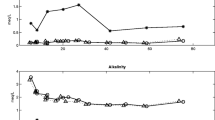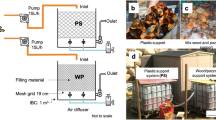Abstract
Performance of raw and two Fe-loaded biochars, produced either by evaporation (E-product, 26.9% Fe) or precipitation (P-product, 12.6% Fe), was evaluated in batch and column testing for As(V) and Sb(III) removal from contaminated neutral drainage (CND). Batch testing results showed that sorption capacity of the E-product tripled for As(V) and quintupled for Sb(III), whereas for the P-product, it doubled for both contaminants, relative to the raw biochar. Moreover, As(V) removal by the E-product reached 90% in less than 8 h, for initial concentrations up to 50 mg/L. In column testing, the E-product efficiently treated the influent [pH 6; 1 mg/L As(V)] for more than 286 days. The pH of the final effluent was within the legally allowed limits (6–9.5) while less than 0.3 mg/L Fe leached out. Based on these findings, Fe-loaded biochar by evaporation (E-product) seems promising for As(V) treatment in CND.



Similar content being viewed by others
References
Agrafioti E, Kalderis D, Diamadopoulos E (2014) Ca and Fe modified biochars as adsorbents of arsenic and chromium in aqueous solutions. J Environ Manag 146:444–450
Al-Degs YS, El-Barghouthi M, Issa A, Khraisheh M, Walker G (2006) Sorption of Zn(II), Pb (II), and Co (II) using natural sorbents: equilibrium and kinetic studies. Water Res 40:2645–2658
Alidoust D, Kawahigashi M, Yoshizawa S, Sumida H, Watanabe M (2015) Mechanism of cadmium biosorption from aqueous solutions using calcined oyster shells. J Environ Manag 150:103–110
American Society for Testing and Materials ASTM (1995) Standard test method for pH of soils. In: Annual book of ASTM standards vol 04.08 Section D4972-95a, pp 27–28, West Conshohocken PA
Ansone L, Klavins M, Viksna A (2013) Arsenic removal using natural biomaterial-based sorbents. Environ Geochem Health 35:633–642
Ashley PM, Craw D, Graham BP, Chappell DA (2003) Environmental mobility of antimony around mesothermal stibnite deposits, New South Wales, Australia and southern New Zealand. J Geochem Explor 77:1–14
Bakatula EN, Richard D, Neculita CM, Zagury GJ (2018) Determination of point of zero charge of natural organic materials. Environ Sci Pollut Res 25:7823–7833
Beesley L, Marmiroli M (2011) The immobilization and retention of soluble arsenic, cadmium and zinc by biochar. Environ Pollut 159:474–480
Belviso C, Cavalcante F, Di Gennaro S, Lettino A, Palma A, Ragone P, Fiore S (2014) Removal of Mn from aqueous solution using fly ash and its hydrothermal synthetic zeolite. J Environ Manag 137:16–22
Biswas BK, Inoue J, Kawakita H, Ohto K, Inoue K (2009) Effective removal and recovery of antimony using metal-leaded saponified orange waste. J Hazard Mater 172:721–728
Braghiroli FL, Bouafif H, Neculita CM, Koubaa A (2018a) Activated biochar as an effective sorbent for organic and inorganic contaminants in water. Water Air Soil Pollut 229:230
Braghiroli FL, Bouafif H, Hamza N, Neculita CM, Koubaa A (2018b) Production, characterization, and potential of activated biochar as ad sorbent for phenolic compounds from leachates in a lumber industry site. Environ Sci Pollut Res 25:26562–26575. https://doi.org/10.1007/s11356-018-2712-9
Bright DA, Sandys N (2015) Beyond ML/ARD: the many faces of neutral mine drainage in the context of mine closure. Mine Closure, Vancouver 10p
Calugaru IL, Neculita CM, Genty T, Zagury GJ (2018) Metals and metalloids treatment in contaminated neutral effluents using modified materials. J Environ Manag 212:142–159
Centre d’expertise en analyse environnementale du Québec CEAEQ (2003) Détermination de la matière organique par incinération : méthode de perte au feu (PAF). MA. 1010-PAF 1.0., Quebec’s Ministry of Environment, 9p
Dobran S, Zagury GJ (2006) Arsenic speciation and mobilization in CCA-contaminated soils: influence of organic matter content. Sci Total Environ 364:239–250
Dong X, Ma LQ, Li Y (2011) Characteristics and mechanisms of hexavalent chromium removal by biochar from sugar beet tailing. J Hazard Mater 190:909–915
Ghanizadeh G, Ehrampoush MH, Ghaneian MT (2010) Application of iron impregnated activated carbon for removal of arsenic from water. Iran J Environ Health Sci Eng 2:145–156
Han L, Sun H, Ro KS, Sun K, Libra JA, Xing B (2017) Removal of antimony (III) and cadmium (II) from aqueous solutions using animal manure-derived hydrochars and pyrochars. Bioresour Technol 234:77–85
Ho YS, McKay G (1998) A comparison of chemisorption kinetic models applied to pollutant removal on various sorbents. Process Saf Environ 76:332–340
Kolbe F, Weiss H, Morgenstern P, Wennrich R, Lorenz W, Schurk K, Stanjek H, Daus B (2011) Sorption of aqueous antimony and arsenic species onto akaganeite. J Colloid Interface Sci 357:460–465
Kumar PS, Ramalingam S, Abhinaya RV, Kirupha SD, Murugesan A, Sivanesan S (2012) Adsorption of metal ions onto the chemically modified agricultural waste. Clean Soil Air Water 40:188–197
Larios R, Fernández-Martínez R, Silva V, Loredo J, Rucandio I (2012) Arsenic contamination and speciation in surrounding waters of three old cinnabar mines. J Environ Monit 14:531–542
Lee H, Kim D, Kim J, Ji MK, Han YS, Park YT, Yun HS, Choi J (2015) As(III) and As(V) removal from the aqueous phase via adsorption onto acid mine drainage sludge (AMDS) alginate beads and goethite alginate beads. J Hazard Mater 292:146–154
Li H, Dong X, da Silva EB, de Oliveira LM, Chen Y, Ma LQ (2017a) Mechanisms of metal sorption by biochars : biochar characteristics and modifications. Chemosphere 178:466–478
Li X, Yang H, Zhang C, Zeng G, Liu Y, Xu W, Wu Y, Lan S (2017b) Spatial distribution and transport characteristics of heavy metals around an antimony mine area in central China. Chemosphere 170:17–24
Lindsay MBJ, Moncur MC, Bain JG, Jambor JL, Ptacek CJ, Blowes DW (2015) Geochemical and mineralogical aspects of sulfide mine tailings. Appl Geochem 57:157–177
Liu B, Jian M, Wang H, Zhang G, Liu R, Zhang X, Qu J (2018) Comparing adsorption of arsenic and antimony from single-solute and bi-solute aqueous systems onto ZIF-8. Colloids Surf A Physicochem Eng Asp 538:164–172
Ministère du Développement Durable, Environnement et Lutte contre les Changements Climatiques du Québec MDDELCC (2012) Directive 019 sur l’industrie minière, http://www.mddelcc.gouv.qc.ca/milieu_ind/directive019/. Accessed 15 Aug 2018
Ministry of Justice, Metal Mining Effluent Regulations MMER (2015) (SOR/2002–222); Government of Canada. http://laws-lois.justice.gc.ca/eng/regulations/SOR-2002-222/. Accessed 15 Aug 2018
Mohan D, Pittman CU Jr, Bricka M, Smith F, Yancey B, Mohammad J, Steele PH, Alexandre-Franco MF, Gómez-Serrano V, Gong H (2007) Sorption of arsenic, cadmium, and lead by chars produced from fast pyrolysis of wood and bark during bio-oil production. J Colloid Interface Sci 310:57–73
Mondal P, Balomajumder C, Mohanty B (2007) A laboratory study for the treatment of arsenic, iron, and manganese bearing ground water using Fe3+ impregnated activated carbon: effects of shaking time, pH and temperature. J Hazard Mater 144:420–426
Nordstrom K, Blowes DW, Ptacek CJ (2015) Hydrogeochemistry and microbiology of mine drainage: an update. Appl Geochem 57:3–16
Ondrejková I, Ženišová Z, FǏaková R, Krčmář D, Sracek O (2013) The distribution of antimony and arsenic in waters of the Dúbrava abandoned mine site, Slovak Republic. Mine Water Environ 32:207–221
Ordoñez A, Silva V, Galán P, Loredo J, Rucandio I (2014) Arsenic input into the catchment of the River Caudal (Northwestern Spain) from abandoned Hg mining works: effect on water quality. Environ Geochem Health 36:271–284
Palmer K, Ronkanen A-K, Kløve B (2015) Efficient removal of arsenic, antimony and nickel from mine wastewaters in Northern treatment peatlands and potential risks in their long-term use. Ecol Eng 75:350–364
Poguberovi SS, Krčmar DM, Maletić SP, Kónya Z, Pilipović DDT, Kerkez DV, Rončević SD (2016) Removal of As(III) and Cr(VI) from aqueous solutions using “green” zero-valent iron nanoparticles produced by oak, mulberry and cherry leaf extracts. Ecol Eng 90:42–49
Qi P, Pichler T (2017) Competitive adsorption of As (III), As (V), Sb (III) and Sb (V) onto ferrihydrite in multi-component systems: implications for mobility and distribution. J Hazard Mater 330:142–148
Salameh Y, Albadarin AB, Allen SJ, Walker G, Ahmad MNM (2015) Arsenic (III, V) adsorption onto charred dolomite: charring optimisation and batch studies. Chem Eng J 259:663–671
Samsuri AW, Sadegh-Zadeh F, Seh-Bardan BJ (2013) Adsorption of As(III) and As(V) by Fe coated biochars and biochars produced from empty fruit bunch and rice husk. J Environ Chem Eng 1:981–988
Sasaki T, Iizuka A, Watanabe M, Hongo T, Yamasaki A (2014) Preparation and performance of arsenate (V) adsorbents derived from concrete wastes. Waste Manag 34:1829–1835
Sekula P, Hiller E, Šottník P, Jurkovič L, Klimko T, Vozár J (2018) Removal of antimony and arsenic from circum-neutral mine drainage in Poproč, Slovakia: a field treatment system using low-cost iron-based material. Environ Earth Sci 77:518
Sizmur T, Fresno T, Akgül G, Frost H, Moreno-Jiménez E (2017) Biochar modification to enhance sorption of inorganics from water. Bioresour Technol 246:34–47
Stantec Consulting Ltd (2004) Review of water quality issues in neutral pH drainage: examples and emerging priorities for the mining industry in Canada. MEND (Mine Environment Neutral Drainage) Report 10.1 prepared by Stantec consulting Ltd., Brampton, Canada
Takeno N (2005) Atlas of eh-pH diagrams, Intercomparison of thermodynamic databases. National Institute of Advanced Industrial Science and Technology, Research Center for Deep Geological Environments, Geological Survey of Japan, Report No. 419, p 287
Ungureanu G, Santos S, Boaventura R, Botelho C (2015) Arsenic and antimony in water and wastewater: overview of removal techniques with special reference to latest advances in adsorption. J Environ Manag 151:326–342
Wang S, Gao B, Li Y, Creamer AE, He F (2017) Adsorptive removal of arsenate from aqueous solutions by biochar supported zero-valent iron nanocomposite: batch and continuous flow test. J Hazard Mater 322:172–181
Wilson NJ, Craw D, Hunter K (2004) Contribution of discharges from a historic antimony mine to metalloid content of river waters, Marlborough, New Zealand. J Geochem Explor 84:127–139
Wu D, Sun S-P, He M, Wu Z, Xiao J, Chen XD, Wu WD (2018) As(V) and Sb(V) co-adsorption onto ferrihydrite: synergistic effect of Sb(V) on As(V) under competitive conditions. Environ Sci Pollut Res 25:14585–14594
Xu X, Cao X, Zhao L (2013) Comparaison of rice husk—and dairy manure—derived biochars for simultaneously removing heavy metals from aqueous solutions: role of mineral components in biochars. Chemosphere 92:955–961
Zhang W, Zheng J, Zheng P, Tsang DCW, Qiu (2015) Sludge-derived biochars for arsenic (III) immobilization: effects of solution chemistry on sorption behavior. J Environ Qual 44:1119–1126
Author information
Authors and Affiliations
Corresponding author
Additional information
Responsible editor: Ioannis A. Katsoyiannis
Publisher’s note
Springer Nature remains neutral with regard to jurisdictional claims in published maps and institutional affiliations.
Electronic supplementary material
ESM 1
(DOCX 1165 kb)
Rights and permissions
About this article
Cite this article
Calugaru, I.L., Neculita, C.M., Genty, T. et al. Removal efficiency of As(V) and Sb(III) in contaminated neutral drainage by Fe-loaded biochar. Environ Sci Pollut Res 26, 9322–9332 (2019). https://doi.org/10.1007/s11356-019-04381-1
Received:
Accepted:
Published:
Issue Date:
DOI: https://doi.org/10.1007/s11356-019-04381-1




